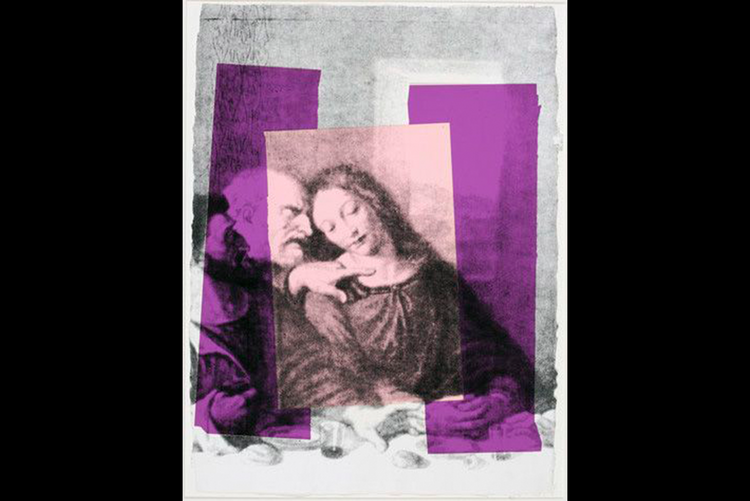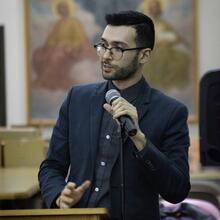I awaited the opening of “Andy Warhol: Revelation” at the Brooklyn Museum with great anticipation. The exhibit, which “explores the artist’s lifelong relationship with his faith that frequently appeared in his artworks,” features both his own works and Catholic devotional items that he collected. Juxtaposed against the other collections on display in the museum, the exhibit highlights how Warhol’s keen attention to paradox makes him a paragon of what it means to live as a Catholic in a postmodern culture.
The term “postmodern” is ambiguous and often thrown around loosely. Postmodernity in a historical sense can refer generally to events or cultural sensibilities that emerged after the Modern era, which ended roughly after World War II. Postmodernist philosophy refers to a specific school of thought that rose to prominence in France in the 1960s.
Starting with French philosophers like Jacques Derrida, Jacques Lacan and Michel Foucault, postmodern philosophy aims mainly to call into question the basis of certain commonly accepted hierarchies, institutions and truth claims. In the emblematic words of Derrida, “everything that has been said must be unsaid.” Postmodern philosophy also challenges the Enlightenment’s emphasis on rationality and pure objectivity. These thinkers have played a significant role in shaping the sensibilities of numerous artistic trends since the 1960s—think of Warhol’s Pop Art, the Performance Art of Marina Abramovic, or the Installation Art of Allan Kaprow.
The show reveals Warhol as a paragon of what it means to live as a Catholic in a postmodern culture.
Most of the exhibits in the Brooklyn Museum employ the use of postmodernist concepts to address matters having to do with identity, desire, injustice and suffering. So the installation outside of the museum by Nick Cave, which consists of the words “TRUTH BE TOLD” in black letters running along the wall, “question[s] the precarious nature of truth in our society” and “comment[s] on how words can be warped and distorted by those in power.” “The Slipstream” is likewise a collection of pieces on the first floor of the museum that “seeks to hold space for individuals to find their feelings of fear, grief, vulnerability, anger, isolation, and despair—as well as joy, determination, and love.”
There are plenty of vocal critics of the postmodernist movement, including Jordan Peterson and Camille Paglia, as well as Catholics like Bishop Robert Barron. But for Catholics, “Andy Warhol: Revelation” might serve as a bridge between postmodern concepts and their religious beliefs. As literary critic Wayne C. Booth once wrote, “postmodernist theories of the social self have not explicitly acknowledged the religious implications of what they are about. But if you read them closely, you will see that more and more of them are talking about the human mystery in terms that resemble those of the subtlest traditional theologies.”
It is true that postmodernism’s overwhelming emphasis on personal experience can run the risk of denying both God’s existence and the entire Judeo-Christian moral framework. But that emphasis can also help us to recognize the need for God as it manifests within our personal experiences. Postmodern culture does not necessarily have to lead us toward relativism and pure subjectivism—where truth is whatever I say it is, where one can possess “alternative facts.” Instead, postmodernism’s attention to paradox and unconventionality can serve to open up questions that lead us to rediscover objective spiritual truths.
Postmodernism can also help us to recognize the need for God as it manifests within our personal experiences.
After all, what is more paradoxical and unconventional than the founding story of Christianity itself: An all powerful God becomes a helpless child; an eternal deity gives up his very life.
The entrance to the Warhol exhibit testifies to this possibility. The walls are covered in an expanded version of Warhol’s 1963 “Crowd,” which was a screen print of a newswire photo of the crowd in St. Peter’s Square on Easter Sunday 1955. The expanded version was produced by the Brooklyn-based collective Flavor Paper, whose creative director added an image of Warhol in a striped shirt, rendering it reminiscent of the famous Where’s Waldo? books. Here, it is Where’s Warhol?
This juxtaposition between Warhol and the crowd highlights Warhol’s own search for his identity. The screen print evokes the postmodern impulse to do away with social roles and expectations in order to “invent” our authentic selves. Yet Warhol allows this impulse to lead him not to a vague relativistic answer about who he is, but rather to embark on a journey toward discovering his true identity in Christ.
The exhibit invites viewers to consider how Warhol’s belief in the incarnation shaped his attention to the beauty within both the mundane elements of our human experience and the more chaotic and complex parts of humanity. Warhol had faith in the infinite God who humbled himself and entered the physical realm as a human, who offered himself as bread to eat, who ultimately allowed himself to be killed out of love for humanity. Was it that faith that fanned the flames of his obsession with consumerism and death?
Warhol allows this impulse to lead him on a journey toward discovering his true identity in Christ.
If so, this belief manifests most prominently in his reproductions of labels of popular brands. From the famous Campbell’s soup cans to the Heinz ketchup boxes, Warhol finds beauty in the packaging of these products. At the same time, the viewer gets the sense that Warhol finds the pleasure of consuming these things to be finite and ultimately vapid. The exhibit space juxtaposes the Heinz boxes with screen print reproductions of images of Black Civil Rights protestors being attacked by police dogs. The placing of the pieces points to Warhol’s intuition that a society constructed upon capitalistic power and the drive to consume is lethal.
Similarly, in “The Last Supper (Be Somebody with a Body)” he critiques his own fixation on youthful male beauty and on his own health and fitness by superimposing the image of Jesus consecrating the Eucharist at the Last Supper over the image of a young muscular fitness model. It is as if his consumption of Christ’s body fills in the emptiness left behind after the temporary pleasure of gazing upon the beauty of a young man.
Warhol’s fascination with the paradox between the sacred and profane, the natural and artificial is indebted to his camp sensibility. While difficult to pin down, camp is generally characterized as a celebration of artifice, irony, the unconventional and what is generally considered to be in bad taste.
Warhol’s fascination with the paradox between the sacred and profane is indebted to his camp sensibility.
Camp has its roots in the turn-of-the-century aesthetes and Decadent writers, many of whom converted to Catholicism. The work of figures like Oscar Wilde, Charles Baudelaire and Joris-Karl Huysmans is caught up in the tension between the extremes of self-indulgence and devotion to God, of sin and sanctity. It has been condemned by some as irresponsible, or even immoral. But the fact that camp does not pretend not to be bad can pry open the door to seeking that which is genuinely true, good and beautiful.
By intentionally putting that which is artificial, unnatural and even sinful on display, and not pretending that it is otherwise, camp works like a negative film strip. It forces us to ask if there exists something real, true or even sacred beyond the artifice.
Warhol’s exaltation of glamorous female icons is typical of camp. His “Jackie”series, blue toned silkscreen prints of a veiled Jackie O. at the funeral of JFK, evokes Marian imagery. His “Marilyn Diptych”shows a vibrantly colorful series of Marilyn Monroe silkscreen prints slowly fading into dull black and white prints. His depictions of them imitate the Byzantine iconography of Mary displayed in the iconostasis, or icon screen, of his family’s Ruthenian Catholic parish. These odes to goddess-like celebrities are always tinged with some kind of darkness, pointing to how the cult of celebrity must always come to an end.
His “Jackie”series, blue toned silkscreen prints of a veiled Jackie O. at the funeral of JFK, evokes Marian imagery.
The extensive amount of pieces and their thoughtful arrangement in the Brooklyn Museum exhibit is to be commended. It was also impressive to find amongst his works of art his baptismal certificate, the crucifix that hung above his mantle and his collection of holy cards and kitschy gift shop-grade reproductions of Catholic art and statues.
The museum’s commentary on the pieces (as curated by José Carlos Diaz) seemed to dwell on the presumedly irreconcilable tension between Warhol’s same-sex attraction and the Catholic Church’s moral teachings. Judging by the depth and honesty of his works, it seemed instead to me that the church’s teachings on chastity strengthened rather than weakened his artistic sensibility and keen attention to paradox. Though he was known for his voyeurism and pornographic art, Warhol was also famous for his commitment to celibacy. One can perhaps presume that he made this choice out of self-loathing or “Catholic guilt.” But again, his works would seem to point against such simplistic readings. Instead, it implies that his choice to remain celibate was rooted in real convictions about faith, beauty and the body.
I walked away from “Revelation”with a newfound appreciation of how faith in the incarnation can allow us to engage with our postmodern culture in a more nuanced way than merely rejecting it or assimilating it. In Warhol’s work, Christ’s beauty is not something wholly apart from the human attraction to the artificial, the sinful and the self-indulgent. Rather, Christ reveals how all of his creation is a beautiful gift, even if our ways of engaging with it may be imperfect or selfish.
God does not force me to choose between right and wrong, but calls me to offer my whole self to him, my virtues, weaknesses and weird idiosyncrasies, and so become one with him.
For many people, postmodernism’s wholesale questioning of social norms can lead to the point of denying that there are any real answers to life’s most vital questions. But in bringing the postmodern artistic sensibility to its furthest limits, Warhol affirms that to be truly authentic is to seek to live in communion with one’s maker.








